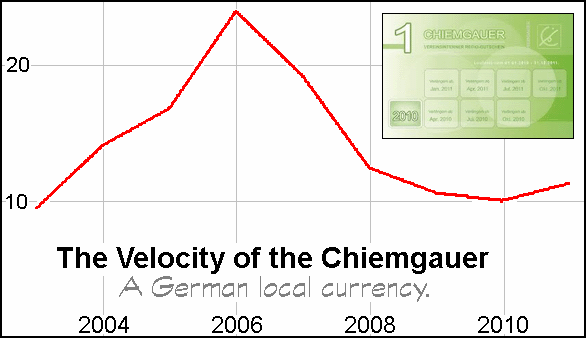Hoarded Money has no value.
The Economics of Velocity.
Introduction.
by
Andy Chalkley
2016
Introduction
 Transactions are required for commerce to occur. Without transactions, there is no commerce. If transactions are inhibited, the transfer of goods and services is interrupted. It is very necessary for money to move for commercial activity to occur. Money that never moves is of no use to society. It is the movement of money that feeds you and me. When money moves, goods move and services are rendered. When money is inhibited from movement, so is the movement of goods and the provision of services. If all money were to become hoarded, all money would cease to move and you and I would cease to eat. We would soon cease to be. Our forefathers, before the invention of writing, invented money tokens to circulate amongst persons that ‘did not know each other’ to facilitate trade and interpersonal services. They invented it to move. The value of money lies in its ability to facilitate the movement of goods and the provision of services. This is the very reason that money was invented. It was invented for no other purpose. Anything that inhibits the movement of money, inhibits the transfer of goods and services. The hoarding of money is the primary way that money is inhibited from displaying its magic. Yet, I can find very little on the subject of hoarding of money. To carry my learning further, I needed to know the relative volumes of Hoarded Money and Circulating Money. After two years of analysis, I made progress and the results were surprising.
Transactions are required for commerce to occur. Without transactions, there is no commerce. If transactions are inhibited, the transfer of goods and services is interrupted. It is very necessary for money to move for commercial activity to occur. Money that never moves is of no use to society. It is the movement of money that feeds you and me. When money moves, goods move and services are rendered. When money is inhibited from movement, so is the movement of goods and the provision of services. If all money were to become hoarded, all money would cease to move and you and I would cease to eat. We would soon cease to be. Our forefathers, before the invention of writing, invented money tokens to circulate amongst persons that ‘did not know each other’ to facilitate trade and interpersonal services. They invented it to move. The value of money lies in its ability to facilitate the movement of goods and the provision of services. This is the very reason that money was invented. It was invented for no other purpose. Anything that inhibits the movement of money, inhibits the transfer of goods and services. The hoarding of money is the primary way that money is inhibited from displaying its magic. Yet, I can find very little on the subject of hoarding of money. To carry my learning further, I needed to know the relative volumes of Hoarded Money and Circulating Money. After two years of analysis, I made progress and the results were surprising.
I have developed a method for calculating the volume of Hoarded Money. I have calculated that, very often, greater than ninety percent of money is hoarded. Most money is sitting idle in bank accounts. Many people put money in bank accounts and allow it to sit idle for years. Only a small portion of the Money Supply is actually moving in transactions. This creates a problem. We need money to live and so more money is generated to compensate. Unfortunately, this generates more debt, so we constantly need to find new items on which to hang debt. We draw lines on maps and hang debt on the divided land. There is such a great need to augment the Money Supply by more borrowing that we even load debt onto our students on whom we will shortly rely to operate an efficient nation. Besides the debt, there are a host of other problems created by hoarding.
We rely on money to operate as a civilisation. It is the transactions enabled by money that allow us to exist in a civilisation. Without the transactions enabled by money, we cannot move food from farms to citizens. The movement of money is essential for civilisation. We cannot live in cities and receive food from farms without money. Yet, most money is sitting idle. If someone spends their money within one day, their money has a velocity of 365. This money is changing hands 365 times in a year. A velocity of 365 is the velocity one might expect for a fruit shop, a flower seller or a beggar. Each of these spend their money within one day. Some of their money may move twice in a day, giving a velocity of 730. If someone spends their money within one week, their money has a velocity of 52. This would apply to a weekly wage earner who is broke by the next wage day. This money is changing hands 52 times a year. The Bitcoin hit a velocity of 36 in 2014. [1] A local currency in Germany called the Chiemgauer has run at a velocity of twenty-four. A Great Depression complementary currency from Okmulgee, USA ran at one hundred. [2] Mason City and Santa Cruz had complementary currencies running at a velocity of around fifty. [2] Most central bank issued currencies are running at a velocity of two or one. In our society, money is only being spent once or twice in a year. Most money is being hoarded. Very little money is circulating. Velocities for most countries fall in the range of 1 to 2.
Here are some typical velocity graphs. Velocity is falling and more money is being hoarded:
High velocity is possible:
I needed a way to calculate the percentage and the volume of Hoarded Money. How long should persons hold money between transactions? There is no fixed rule for this. The nature of money is such that there is no fixed figure that defines some money as Hoarded Money and some as Circulating Money. After much deliberation, I chose an arbitrary figure of one month. Money that changes hands in less than one month, I deem to be Circulating Money. Money that sits idle for more than one month, I deem to be Hoarded Money. This convenient cut-off allows a fascinating insight into the workings of our money system. Surprising understandings come from this simple approach. Whether the monthly period is ideal, is of little consequence because we are interested in the effects of hoarding. Other timespans will allow the same money system comprehension.
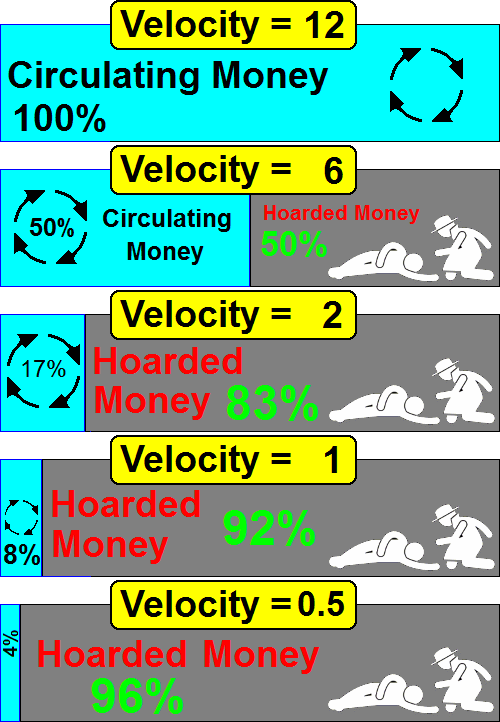
At a velocity of two, 83% of money is hoarded and 17% of money is circulating. At a velocity of one, 92% of money is hoarded and 8% of money is circulating. Almost all of our money is being hoarded. I now show you the velocity graph for Canada along with a graph of the percentage of Hoarded Money and a graph showing the volume of Hoarded Money:
Here is a graph of the percentages of Circulating Money and Hoarded Money:
Before the economists confuse you, here is a graph showing the volume of Circulating Money and Hoarded Money:
For the economists: The velocity fell because the Circulating Money fell and not because hoarding increased. The volume of Hoarded Money did not increase.
Now for an astonishing graph that shows the Money Supply (which consists of Circulating Money and Hoarded Money) along with combined Government Debt and Private Debt.
Our hoarding of money causes many complex problems. Some of these are not evident until a comprehensive study of Circulating Money and Hoarded Money is undertaken. I list a few here and more appear later in the book:
- Our society relies on money circulating so that we can feed, clothe and house ourselves. It is the movement of money that enables a society to operate.
- Most of our money is borrowed into existence. This means that more debt has to be generated to provide money beyond hoarding so that there is money to circulate. The result is that we have to find more and more things on which to hang debt. We have drawn lines all over the map and hung debts on the divided land. The government borrows to obtain money. We have credit card debt and car loans. We have become so desperate that we hang debt on our young students.
- The idle Hoarded Money remains almost completely untaxed.
- Almost all interest is taken from Circulating Money. The logic is that persons with Hoarded Money do not need to borrow.
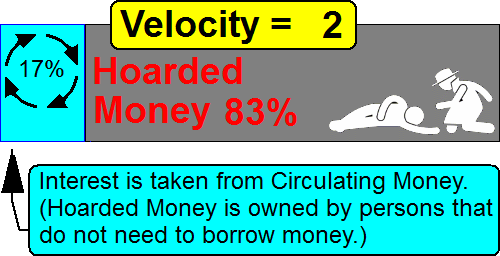
- Interest tends to be taken from Circulating Money which decreases the velocity by increasing the ratio of Hoarded Money to Circulating Money.
- Almost all tax is taken from Circulating Money. Almost no tax is taken from Hoarded Money.
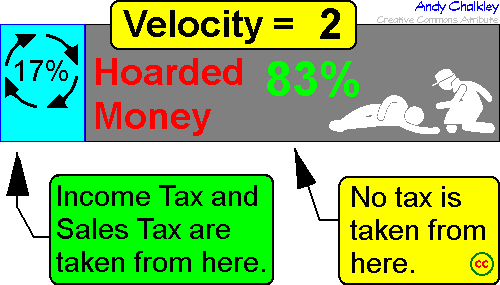
- We worship those that take money out of circulation by hoarding it.
- This Hoarded Money is like the snow on a mountainside waiting to avalanche. The Hoarded Money is a hyperinflation waiting to happen. If all the money in ‘tax havens’ suddenly came out to play in the real economy, a massive inflationary event would occur, from which we may not be able to recover. We may not be able to neutralize this cascading catastrophe. I discuss how to prevent this.
- Those that have ‘more money than they can spend’, tend to be very astute and put great effort into magnifying their hoardings.
- Our astute hoarders apply political pressure to assist their hoarding by gaining tax advantages to the extent that unearned income is taxed more favourably than income from sweat and toil. Tax due on asset appreciation is deferred to the future often indefinitely.
- When there is a high level of hoarding, a nation experiences significantly different economic characteristics. This can only be studied when the mechanics of money hoarding is understood. This book unravels the mechanics of hoarding.
- When a country has a low velocity, it becomes unusually sensitive to minor changes in the Money Supply.
- My study of Circulating Money allows me to explain the factors that cause recessions.
- My study of Circulating Money allows me to explain the procedures needed to revive an economy.
- Amongst many surprises was the realisation that low velocity nations are incredibly susceptible to recession with very minor falls in Money Supply. Higher velocity nations are less susceptible to recession.
- When Velocity is low, the cost of providing a circulating medium becomes excessively expensive.
I classify money as Circulating Money or Hoarded Money. In the following chapters, I demonstrate how to calculate the magnitudes of the two. I show how we give a great advantage to Hoarded Money through the tax system. I demonstrate how almost all tax comes from Circulating Money with negative effects on the economy. I show that there are better ways to collect tax. In this graph, you can see that most taxes are taken from Circulating Money. These are transaction stifling taxes:

I show how almost all interest is taken from Circulating Money. This depletes Circulating Money and enhances Hoarded Money. I show how economics commentators make an elementary error when explaining velocity falls during recessions. I show how nations with low velocity are incredibly sensitive to minor changes in Money Supply. A nation with a velocity of one is much more sensitive to minor changes in Money Supply than a nation with a velocity of two. It turns out that a nation with a velocity of one experiencing a one percent fall in the Money Supply is prone to an extraordinary twelve percent fall in Circulating Money. In the following graph, I show the Circulating Money as a percentage of the Money Supply for various velocities. When money is removed from the Money Supply it tends to be taken from Circulating Money. I reduce the Money Supply by 1% in each case. A 1% fall makes little difference in a high-velocity nation, but in a low-velocity nation, there is a potentially disastrous fall in Circulating Money.

In a nation with a velocity of six, a 1% fall causes a Circulating Money fall of 2%. In a nation with a velocity of one, a 1% fall causes a remarkable Circulating Money fall of 12%. I later show that the tax revenue could potentially fall by around 25%. I will also show you something quite remarkable: The fall in government tax revenue can be greater than the amount of money needed to top up the Circulating Money!
This is particularly noticeable in this graph for Canada. In 2008-2009 in Canada, the Money Supply fell by 1.6%. Surprisingly, the Circulating Money fell by 8%. When the Money Supply fell, the reduction had been taken from the Circulating Money rather than the Hoarded Money. Hoarded Money had remained hoarded.
Now look at what happens to Government Tax Revenue. Only scant figures are available for Canada:
With a low velocity, it becomes exceedingly difficult to maintain a Money Supply and in particular to maintain Circulating Money at a steady figure. Very minor changes in the rate at which banks lend money will have disproportionately large effects upon economic activity.
At low velocity, the economy is extremely sensitive to minor falls in the Money Supply.
A small fall in the Money Supply can cause a large fall in Circulating Money.
A small fall in the Money Supply can cause a large fall in Circulating Money and an even larger fall in Government Tax Revenue.
Our current practices tend to restrict and destroy productive activity. A small fall in Circulating Money can cause a significant fall in productive output which tends to cause a huge fall in tax revenue. This graph shows the relationship between Corporate Income Tax and Circulating Money:
A strange observation that I made was that the fall in the tax collection was greater than the fall in Circulating Money. Common-sense is not a flower that grows in everyone’s garden. Our current logic is inadequate. Under such circumstances, the government could spend a little into Circulating Money and harvest a greater amount in tax revenue. I have to be fairly explicit about this. The money must be spent in a manner such that it circulates. It is pointless spending to augment the Money Supply if it falls into the hands of the hoarders.

My study of Hoarded Money has given me some fascinating insight into the errors nations are making in controlling the money in society. Besides operating under unprecedented levels of debt, (as in the next graph) we are operating under unprecedented levels of hoarding. And, strangely enough, the two are tied to each other. I demonstrate how to understand the underlying principles so that better monetary policy decisions can be achieved. With concentration, you may be able to comprehend how Quantitative Easing created greater hoarding and why some economic practices work and others fail. If you like looking at graphs, I have plenty for you. The following diagram was intended to demonstrate the following: Money that flows into Circulating Money is heavily taxed, Money that flows into Hoarded Money is lightly taxed. Money that circulates into Circulating Money is heavily taxed. Money that circulates within Hoarded Money is lightly taxed. Basically, Circulating Money is heavily taxed in every way and Hoarded Money is lightly taxed.
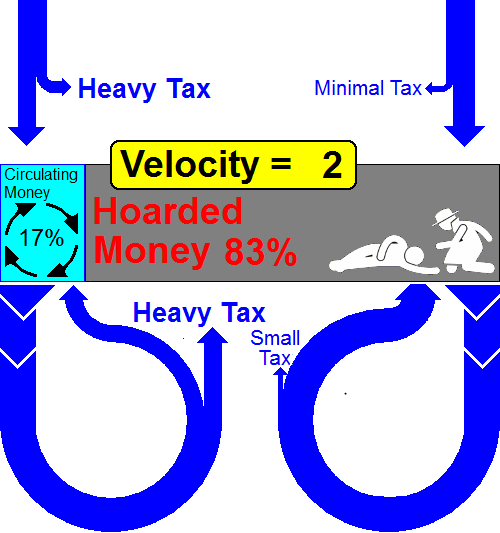
Hoarding is one of the worst things you can do with money. It completely removes money from circulation. It then requires more new tokens to be released. It is false saving as the Hoarded Money has no value. It creates instability. At high rates of hoarding, the economy becomes extremely sensitive to minor changes in Money Supply and hoarding. High levels of hoarding enhance the chance of an avalanche collapse into hyperinflation. Hoarding also encourages a competitive hoarding mentality where individual aspirations override community needs to the extent that laws and tax arrangements get biased towards the hoarder. Saving money is an evil, not a virtue. The hoarding of money has become a competitive evil in our current age and the effects of the hoarding are little studied. I try to remedy the absence of knowledge on Hoarded Money.
I show that maintenance of a constant Circulating Money is particularly difficult when velocity is low which corresponds to a high level of hoarding.
When Velocity is low, the cost of providing a circulating medium becomes excessively expensive.
The level of hoarding is currently reflected in figures for velocity. Reflecting the level of hoarding in this manner hides a number of serious issues that affect modern economies. So many issues are caused by low velocity that are not apparent until the actual level of hoarding and its effects are studied as is done in this book. Until we understand the relationship between Circulating Money, Hoarded Money and the Money Supply, we have little chance of comprehending the factors needed to manage an economy and prevent collapse.
 Transactions are required for commerce to occur. Without transactions, there is no commerce. If transactions are inhibited, the transfer of goods and services is interrupted. It is very necessary for money to move for commercial activity to occur. Money that never moves is of no use to society. It is the movement of money that feeds you and me. When money moves, goods move and services are rendered. When money is inhibited from movement, so is the movement of goods and the provision of services. If all money were to become hoarded, all money would cease to move and you and I would cease to eat. We would soon cease to be. Our forefathers, before the invention of writing, invented money tokens to circulate amongst persons that ‘did not know each other’ to facilitate trade and interpersonal services. They invented it to move. The value of money lies in its ability to facilitate the movement of goods and the provision of services. This is the very reason that money was invented. It was invented for no other purpose. Anything that inhibits the movement of money, inhibits the transfer of goods and services. The hoarding of money is the primary way that money is inhibited from displaying its magic. Yet, I can find very little on the subject of hoarding of money. To carry my learning further, I needed to know the relative volumes of Hoarded Money and Circulating Money. After two years of analysis, I made progress and the results were surprising.
Transactions are required for commerce to occur. Without transactions, there is no commerce. If transactions are inhibited, the transfer of goods and services is interrupted. It is very necessary for money to move for commercial activity to occur. Money that never moves is of no use to society. It is the movement of money that feeds you and me. When money moves, goods move and services are rendered. When money is inhibited from movement, so is the movement of goods and the provision of services. If all money were to become hoarded, all money would cease to move and you and I would cease to eat. We would soon cease to be. Our forefathers, before the invention of writing, invented money tokens to circulate amongst persons that ‘did not know each other’ to facilitate trade and interpersonal services. They invented it to move. The value of money lies in its ability to facilitate the movement of goods and the provision of services. This is the very reason that money was invented. It was invented for no other purpose. Anything that inhibits the movement of money, inhibits the transfer of goods and services. The hoarding of money is the primary way that money is inhibited from displaying its magic. Yet, I can find very little on the subject of hoarding of money. To carry my learning further, I needed to know the relative volumes of Hoarded Money and Circulating Money. After two years of analysis, I made progress and the results were surprising.

